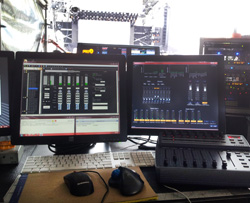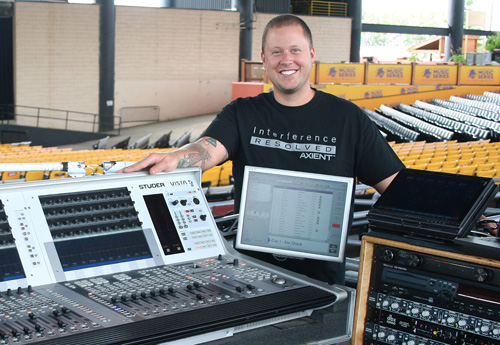
Walk On By
Playing familiar music tracks through the PA is, of course, often done to fine tune the system. Computers and other playback devices are also regularly used to provide background music during walk-in, between sets and of course for walk out.
I particularly enjoyed Burton’s approach: “I tend to listen to music quietly to check the system and like to use a bit of Dusty Springfield or Dionne Warwick as it puts me—and everyone around me—in a good mood. A bit of (Burt) Bacharach mid afternoon never did anyone any harm! I use ‘The Horses’ by Rickie Lee Jones to EQ the system and then check the low end with a bit of Deadmau5.”
When it comes to selecting a laptop, most of the guys I spoke with tend to go with Mac. Burton: “I use a MacBook Pro for playback and always have a pretty large collection of tracks of all genres with me. I use a program called Djay rather than iTunes for playback because it’s easy to set on Auto-Mix, and it can fade between tracks automatically.
“When I do dance gigs, it can even be set to randomly do echo fades, backspins, brake fades and even tempo/beat match! On some shows I can be required to pretend to be a DJ for up to an hour which is really dull…so this makes it fun.”
The interface between the laptop and the mixing desk varies. Mapp: “I travel with a Mac Mini. It’s rack-mounted and runs several programs for system tuning as well as iTunes for walk in/out music. At the beginning of each new tour I collect whatever music the artists wish to have playing and then import it into iTunes, set to shuffle forever, and let it roll. The audio leaves the Mac via the line out, which feeds a Radial JPC (active DI) into the console.”
Opinions Vary
While I was working on this article, Mapp sent me a note asking if he could test out the new Radial USB-Pro, which as a stereo USB-to-XLR interface designed to make it easy to patch the audio out of a laptop and run it into the PA. As it happens, I’d also asked some of these guys what they thought about USB interfaces and as you can imagine, the response varied greatly.
Short is definitively not a member of the USB cable fan club: “I use a 1/8-inch TRS to dual XLR adaptor cable to run the audio and leave the USB connectors for printers and charging my phone.” Burton, however, has the opposite view: “I always use the USB port and I have a bus-powered interface. I also used to have a FireWire interface but the connector is too easy to knock out. The USB is a very solid connector.”
In developing the USB-Pro, we went back and forth between the USB Type A (long flat slot) and the USB Type B (D shaped) and after doing a heap of research, ended up going with USB Type B. It seems that most pros find that the Type B is more robust. But there’s no denying that when using consumer grade connectors like a mini TRS or a USB, greater care is needed… these are not XLRs.
So there’s a lot going on with computers—as well as interfaces and dedicated—inside the gated little cubicle we call FOH. Let’s go to Burton for the final word: “I take great joy in doing walk-in and walk-out music. On The Prodigy, it’s pretty much solid dance beats. but I do like to get a bit of old dub reggae in. For outro we sometimes use ‘Love Is In The Air’ by John Paul Young, and quite often see people dancing all the way out!”
Peter Janis is president of Radial Engineering, which has been producing snake systems, direct boxes and interfaces for more than 20 years.

